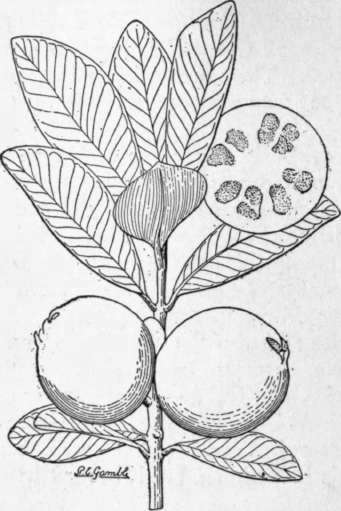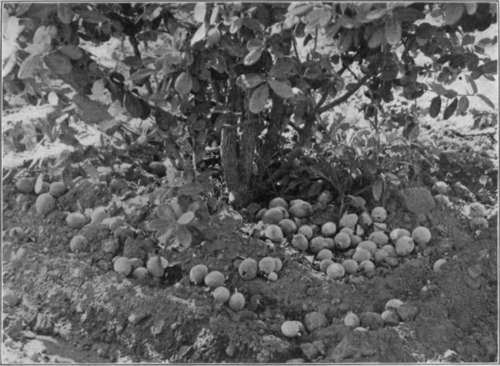The Strawberry Guava (Fig. 36) (Psidium Cattleianum, Sabine)
Description
This section is from the book "Manual Of Tropical And Subtropical Fruits", by Wilson Popenoe. Also available from Amazon: Manual Of Tropical And Subtropical Fruits.
The Strawberry Guava (Fig. 36) (Psidium Cattleianum, Sabine)
Unlike the preceding species, the strawberry guava is subtropical in its requirements, and can be grown wherever the orange succeeds. It is ornamental in appearance, and for this reason has become a favorite garden-shrub in many regions. Though somewhat less valuable than the tropical guava for the commercial production of guava jelly, the fruit is popular with housewives and is put to several uses.
The strawberry guava is ordinarily a bushy shrub, but sometimes becomes a small tree up to 25 feet high. The bark is smooth, gray-brown in color, and the young branchlets are cylindrical (not quadrangular as in P. Guajava). The leaves are elliptic to obovate in outline, acute, 2 to 3 inches long, thick and leathery in texture, somewhat glossy, and deep green in color. The flowers, which are produced singly upon axillary peduncles, are white, and nearly an inch broad. The calyx is obscurely lobed; the corolla is composed of four orbicular petals. The numerous stamens are clustered at the bases of the calyx lobes. The fruit is obovate to round in form, 1 to 1 1/2 inches in diameter, purplish red in color, with a thin skin; the soft flesh, which is white toward the center, contains numerous hard seeds. The flavor is sweet and aromatic, suggesting that of the strawberry (whence the common name). It has not the pronounced muskiness of P. Guajava, and for this reason is preferred by some. The strawberry guava is a native of Brazil, whence it was carried to southern China at an early period, presumably by the Portuguese. From China it was taken to Europe, where it was for some time considered to be native to China and hence was called Chinese guava. It has been planted in India, but is not widely known in that country. According to H. F. Mac-millan, in Ceylon it thrives at elevations of 2000 to 4000 feet. In the Mediterranean region it succeeds in southern France, Spain, Algeria, and elsewhere. It is grown in Hawaii, but is not common there. In Mexico, Central America, and the West Indies it is occasionally seen in gardens. In Brazil, its native home, it is nowhere extensively cultivated. In the United States it thrives in both Florida and California.

Fig. 36. The strawberry guava (Psidium Cattleianum), a hardier species than the common guava. (X 1/2)

Plate XIV. Feijoas ready for gathering.
Besides the name strawberry guava, the terms Cattley guava and Chinese guava are sometimes applied to this species. In Brazil it is known as araca da praia and araca vermelho. Nurserymen in the United States have sent out seedling races or horticultural forms of this species under several botanical names; the yellow-fruited form (variety lucidum of horticulture) has been listed as PMium lucidum, P. chinense, and P. sinense. A form distributed in California under the name P. acre, Ten., has proved to be identical with the yellow-fruited strawberry guava, except in its elongated fruits. Otto Berg considered P. Cattleianum and P. littorale, Raddi, synonyms of P. variabile, Berg; more recently, however, the two last-named species have been included under P. Cattleianum. A large-fruited guava which appears to be nothing more than a form of this species has been distributed in California under the name Psidium Araca. It is similar to the yellow-fruited strawberry guava, except in its larger and broader leaves, larger fruit, and fewer seeds.
The fruit is used principally for jelly-making, but is sometimes eaten out of hand. An analysis made at the University of California showed the ripe fruit to contain: Water 79.42 per cent, ash 0.77, protein 0.88, fiber 6.58, total sugars 5.06, starch, etc., 6.49, and fat 0.80.
Like other species of Psidium, the strawberry guava succeeds on a wide variety of soils. A rich sandy loam seems to suit it best, but it grows well on red clay and on adobe. It is not quite so successful on shallow sandy soils. The mature plant withstands severe frosts without serious injury; temperatures of 22° above zero have not killed it. A dry climate suits it better than a moist one, if the soil is irrigated with reasonable frequency. It is fairly drought-resistant.
Young plants 12 inches high may be set in the open ground in the positions they are to occupy permanently. They may be spaced 10 X 10 feet in California, but in the tropics, and on rich soil, they should be somewhat farther apart. They require the same cultural treatment as the tropical guava. During the first few years the plants retain a compact bushy form; later they may develop trunks and become small trees. They need very little pruning.
Propagation is usually by seed, which method is more satisfactory with the strawberry guava than it is with many other of the fruits here discussed, since there is less variation among seedlings. Particularly choice varieties cannot, however, be propagated by this means. Cuttings are sometimes grown, and the species may be budded in the same manner as Psidium Guajava. Seeds are germinated as in that species.
The plants come into bearing very early and should produce a few fruits the second or third year after planting. Their growth is slow; hence good crops cannot be expected until the plants are five or six years old. The season of ripening in Florida and California is from August to October.
The strawberry guava suffers much less from the attacks of insect parasites than does the tropical guava. As a garden plant in California and Florida it has thus far been subject to few pests.
No horticultural varieties have as yet been established. The seedling race or botanical variety lucidum, known as the Chinese or yellow Cattley guava, differs from the typical strawberry guava in its sulfur-yellow color and more delicate flavor. It is very productive, and so far as is known, comes true when grown from seed.
Continue to:


